Jennifer Bohnhoff's Blog
November 27, 2025
Spooky Fun for Middle Grade Readers

Halloweenon the Butterfield Trail
Published October 2025 by TCUPress
Hardback,123 pages, $19.99.
When eleven-year-old twins Bird and Wiley join their father and mother on a stagecoach ride alongthe Butterfield Trail, they expect adventure but feel very differently about it. Bird is the kind of boy who craves it. He loves being in on the action and is always moving, always doing, and usually getting himself into trouble. He wants to sit up top in the driver's seat with his father. Wiley is just the opposite; he likes to read about adventure, but doesn't like to experience any hardships. Wiley is happy to stay in the cab, although even that is a little bouncier and dust-choked than he would like.
An encounter with Zeb at a river crossing makes Bird think about fairness and equality. Zeb is a slave boy doing a man's work of poling the ferry across the Red River into Texas under the heavy-handed discipline of another slave. It's no surprise he wants to befree. That night, Zeb steals a horse and crosses the river in search of the $500 that will buy his freedom.
But then things get spooky. A freak storm separates the twins from the coach and they find themselves in a dark woods filled with howling wolves, flapping bats, and rattlesnakes. Spooks appear, too, including ghostly bells, glowing tombstones, headless horsemen, wailing ghostly women, and old forked-tail himself.
In the middle of all this terror they run across Zeb and help him find a hidden treasure only to discover that it's been stolen from hardworking folks.
When they finally reconnect with the stagecoach, they find that their father's been injured and cannot drive the team. Although only a child, Bird must step up and do his father's job. But can he drive the team through a bison stampede?
Dearen peppers the thrills with laugh-out-loud dialog and humorous turns of phrase that will keep readers smiling. I won't say it (an inside joke you will understand if you read the book), but you will be amused.
This may all sound like a rollicking, exciting story, but it will make readers think about deep and important issues. Throughout the book Bird grapples with questions like why he and Zeb can't be friends and which is the greater good: returning stolen money or using it to free a slave. And although this book takes the moral high ground, it does so in a way that's not preachy. Bird, Wiley and Zeb are left to make their own decisions, and so is the reader.
Set in 1860, Dearen has filled this story with words and phrases that were used at the time but feel remarkably fresh to the modern reader. He does a good job of explaining things that modern readers might not understand. The closing chapter tells the history and folklore behind the story and offers suggestions for further reading.Spooky enough to raise the hair on a young head, yet clean and nonviolent enough to keep parents and teachers happy, this would be a great book for October read alouds in upper elementary and middle school classrooms and is a great read for ages 9-13.
I have one hardbound copy to give away. If you'd like to receive it, leave a comment on this blog.
About the Author
 Patrick Dearen grew up in a small town in West Texas. He is the author of twenty-nine books, eighteen of which are adult fiction and ten are adult nonfiction. This is his first book for children. He is a member of the Texas Literary Hall of Fame and has been honored by Western Fictioneers, Academy of Western Artists, San Antonio Conservation Society, West Texas Historical Association, and New Mexico-Arizona Book Awards . His books have been finalists for or won the Peacemaker Award, the Elmer Kelton Award, the Will Rogers Gold Medallion and WWA's Spur Award.Jennifer Bohnhoff is a retired Middle School Language Arts and Social Studies teacher who now writes novels for middle grade through adult readers. You can read more about her books here.
Patrick Dearen grew up in a small town in West Texas. He is the author of twenty-nine books, eighteen of which are adult fiction and ten are adult nonfiction. This is his first book for children. He is a member of the Texas Literary Hall of Fame and has been honored by Western Fictioneers, Academy of Western Artists, San Antonio Conservation Society, West Texas Historical Association, and New Mexico-Arizona Book Awards . His books have been finalists for or won the Peacemaker Award, the Elmer Kelton Award, the Will Rogers Gold Medallion and WWA's Spur Award.Jennifer Bohnhoff is a retired Middle School Language Arts and Social Studies teacher who now writes novels for middle grade through adult readers. You can read more about her books here.
November 20, 2025
The Best Little Maple Farm in Vermont

This past October my husband and I took a road trip to New England. We wanted to visit family and participate in the Mount Desert Island marathon and half marathon near Acadia National Park. But we also wanted to see the fall colors and experience life in the northeastern part of the country.
While planning my itinerary, I scrolled along the roads of New England using google maps. I was delighted when I ran across reviews for Coutures October maple farm and bed and breakfast. Their website said they offered "a true Vermont farm Bed and Breakfast experience with an atmosphere of a small family farm with cows that might even wake you up in the morning!" and I was intrigued. This sounded like the singular experience I wanted.
Couture's is located along Vermont Route 100 in Westfield, Vermont, close to the Canadian border. Trails on the property wind through the woods and can be hiked in the summer and cross country skied in the winter. In addition, there is hiking, fishing, biking, canoeing and hunting nearby. It is close to Jay Peak Ski Resort, which is the reason they began the B&B because there was not enough accommodations in the area to meet demand.
If you want modern luxury and a fancy dancy atmosphere, this isn't the place for you. But if you want homey, warm and comfortable, this is it! Jacques and Pauline Couture began farming as teenage newlyweds in 1970, and their whole house, which dates back to 1892, is filled with family mementos. The queen size beds in the comfortable rooms are spread with home-made quilts. More quilts grace the walls and hang on quilt racks. Guests in the three rooms share a bathroom. There is a larger room that can accomodate a family of six that has its own bath.
Staying with the Coutures wasn't like staying at a bed and breakfast; it was like spending a night with your favorite aunt and uncle's house. The Coutures were warm and welcoming, and very proud of their maple products, their family, and their faith. They shared even more of their lives when they sat with us over a delicious homemade breakfast at the kitchen table. Of course, their own maple syrup was the star of the meal.
Staying with the Coutures is a great way to learn about farming in Vermont. The first thing the Coutures did when we arrived was sit us down for a video on the process of maple sugaring. Their brochure says that guests, young and old alike, are welcome to tour their barn, which houses cows, calves, chickens, and cats. In addition too a lot of different maple sugar products, there was a selection of their beef frozen and ready for sale in their shop.
We drove away with the warm feeling that we'd found family we didn't know we had, plus a box full of maple products to share with the family we already had. We would go back in a heartbeat.
Want to know more about the Coutures and their farm? Visit their website and online store.
Jennifer Bohnhoff is a retired English and Social Studies teacher who now writes books for middle grade through adult readers. You can read more about her and her books here.
October 10, 2025
Time for you to get Perspective!
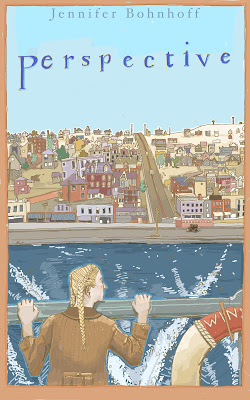
My latest book, Perspective is now out, and I think you need to get a little perspective by reading this book!
Perspective is the story of Genevieve Williams, a twelve year old girl who wants to grow up to be an artist.
The Great Depression is raging, and millions of people are out of work and on the street. Despite the economic turmoil, Genevieve lives a comfortable and quiet life with her mother, a high school English teacher. They live a simple life, without ostentation. She sits and sketches in their Duluth apartment while her mother grades papers and classical records spin on their phonograph. They eat most of their meals out in the little diners that dot the downtown neighborhood and Genevieve spends time in the local parks and libraries. In addition to her schoolwork, her mother is active in the local temperance union and is determined to shut down the speakeasies and bars that continue to serve alcohol despite Prohibition. Genevieve's mother has taken her on raids to such establishments, so Genevieve knows the horror and devastation that alcoholism can bring to a family.


But when Genevieve's mother dies of lung cancer, her whole world comes apart. She is sent to live with her Aunt Gertrude, Uncle Edwin, and their two spoiled sons, and in spite the fact that Uncle Edwin drives a fine DeSoto and Aunt Gertrude wears a mink coat, they announce that they simply cannot keep Genevieve once they discover that they will not be able to put their fingers on her money. Aunt Gertrude buys her niece a one way ticket to Isle Royale, where she is to live with the father she's never known.
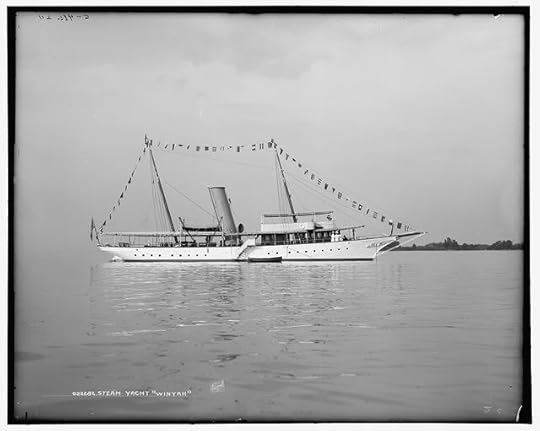
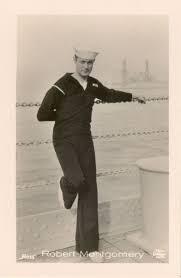
She boards the Winyah and makes friends with a young sailor, but she finds that her stomach is not seaworthy and spends a miserable night wondering about where she is going and what she will find there. Strangely, Genevieve had never questioned her mother about what happened between her and her father. Now she wonders if she's sailing into a horrible situation. Is her father some kind of monster? What will life be on her new island home? The man who meets her at the pier is no monster, but a shy, soft-spoken fisherman. While she and her mother are blonde Scandinavians, Dylan is a black haired Welshman. The two slowly get to know each other and Genevieve learns to love this gentle man.
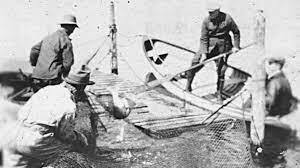 She learns that life on the island is very different than life in urban Duluth. There is no electricity, no indoor plumbing, and no phonographs to play classical music in the background during quiet evenings.
She learns that life on the island is very different than life in urban Duluth. There is no electricity, no indoor plumbing, and no phonographs to play classical music in the background during quiet evenings. There are also no restaurants just around the corner and no school! Genevieve must keep up her studies with correspondence lessons that go through the mail. Worse yet, once the lake freezes over in winter, she and her father will be completely cut off from the mainland.
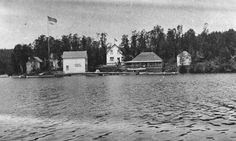 But Dylan and Genevieve are not completely alone. The Torgeson family lives close by. Dylan fishes with the father, and Genevieve becomes a good friend with Ida, the eldest daughter. She develops a crush on Gunnar, who is about her age, and loves playing with the little sisters and brothers. Ida and Mrs. Torgeson help Genevieve learn to cook on a little, wood-burning stove, how to can, and how to keep house without any of the technology that Genevieve must now live without.
But Dylan and Genevieve are not completely alone. The Torgeson family lives close by. Dylan fishes with the father, and Genevieve becomes a good friend with Ida, the eldest daughter. She develops a crush on Gunnar, who is about her age, and loves playing with the little sisters and brothers. Ida and Mrs. Torgeson help Genevieve learn to cook on a little, wood-burning stove, how to can, and how to keep house without any of the technology that Genevieve must now live without. 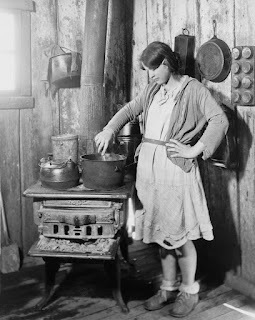 Just as she unravels the mystery of her parents' broken relationship, and learns to love the island's rustic beauty, the government threatens to take it all away. Genevieve must find a way to protect her gentle, but flawed father from an outside world he has never known, and not sacrifice her dreams to become an artist. She must learn to separate her mother's judgements from her own and accept her father for his merits while forgiving him for his failures.
Just as she unravels the mystery of her parents' broken relationship, and learns to love the island's rustic beauty, the government threatens to take it all away. Genevieve must find a way to protect her gentle, but flawed father from an outside world he has never known, and not sacrifice her dreams to become an artist. She must learn to separate her mother's judgements from her own and accept her father for his merits while forgiving him for his failures.Genevieve must learn that perspective is not just a theory in art, but a way of seeing the world through the lens of forgiveness and patience.
Perspective will immerse you into a time and place that is distant but still very much relevant. It is written so that a middle grade reader can read it, but is interesting enough to keep and adult reader happy. I hope you will read it and gain some perspective on not only your world, but Genevieve's.
Jennifer Bohnhoff is a retired English and History teacher. She and her family visited Isle Royale during the summer of 2000, and she was inspired by that trip to write this story. You can learn more about the history of Isle Royale here, and about its wildlife here.
Paperback and ebook copies of Perspective can be bought on Amazon. You can buy a paperback directly from Jennifer Bohnhoff, and she will sign it and include a few goodies when she sends your book.
September 25, 2025
More Middle Grade Historical Fiction about the Great Depression
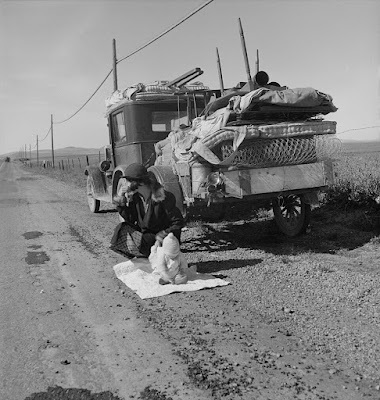
Back in December 2022 I wrote a blog recommending some middle grade books about the Great Depression. In the two and a half years since that blog, I've written my own middle grade historical fiction about the era, and I've read a few more. That means it's time for an update.
Stories set in the Great Depression can benefit middle gradereaders in a number of ways. In addition to offering a glimpse into asignificant period in American history that they are unlikely to be familiarwith, these stories can offer valuable lessons about resilience, hardship, andthe importance of community that readers can apply to their own lives.
Exposing middle grade readers to the economic and socialrealities of the time can broaden their understanding of the past and itsimpact on the present. The Great Depression began with a stock market crash in1929. For the next decade, America (and other countries world wide) experienceda severe global economic downturn that was characterized by high rates ofunemployment that led to social upheaval. Middle Grade readers are severalgenerations removed from this period and might not be aware of what took place.The Great Depression provides a real-world example of economic principles andcrisis management, both on a governmental level and on a personal level.Readers who are exposed to the impact of financial crises, unemployment, andpoverty on characters will begin to grasp how these basic economic conceptsaffected society then, and continue to affect society now.
Many of the middle grade novels set during the GreatDepression highlight the strength and perseverance of individuals andcommunities in the face of adversity. During the Great Depression, almost aquarter of the workforce was unemployed. Many lost their homes to foreclosureor were thrown into the street for lack of rental payments. Families were splitup as fathers searched for work. "Hoovervilles," shanty towns built ofpacking crates, abandoned cars, and other scraps, sprung up across the nation. Youngsterswhose families could no longer support them rode the rails as hobos in searchof work. It took enormous courage to face the wrenching pain of such upheavals.Even those who didn’t lose their homes worried about having enough food. They mendedworn clothing, added cardboard liners to worn out shoes, made do as best asthey could, and sometimes felt deep despair. Their stories can inspire today’s youngreaders to develop their own resilience and grit when facing challenges, and itcan help those readers develop compassion and empathy for today’s downtrodden.
Here are some recommended readings about the GreatDepression for Middle Grade Readers. Read through the whole list. There are several books I'm giving away.
Fiction
Not Lucille by Mike Steele (published by Creative James Media, June 24, 2025, EAN/UPC 9781965648070)
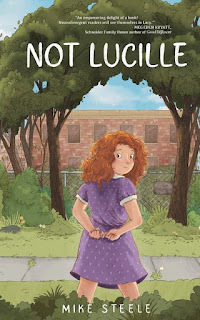
Ten-year-old Lucy Contento can't seem to control her impulsivebehavior, blurting out in the classroom and doing things without thinking. Whenshe's assigned to the rigid disciplinarian Miss Gillingham's Fifth Grade Class,it seems she's destined to spend every afternoon in after school detention,sitting with the teacher who insists on calling her Lucille and making herwrite with her right hand even though she's a Leftie. One afternoon she sneaksonto the campus of the Deefies, what the neighborhood kids disparagingly call a nearby school for the Deaf, and makes a friend ofFlorence, a profoundly deaf girl who doesn't mind Lucy's flaws. From there, thestory of friendship and acceptance blooms. Lucy learns to advocate for bothherself and for Florence as she comes to terms with the quirks that everyonehas, even the straight-laced Miss Gillingham and her grumpy neighbor Mrs.Ricci. This is a sweet and empowering book that will melt your heart and giveyou hope. The author provides an afterword that helps today’s readersunderstand how very different the world was in the 1930s.
Walter Steps up to the Plate bySue Houser (published by
Kinkajou Press, October 10, 2023, EAN/UPC 9781951122683 Twelve-year-old Walter wants to spend the summer of 1927 watching his beloved Chicago Cubs play baseball. Instead, his life is upended when his mother is diagnosed with tuberculosis. Walter leaves everything he knows and loves to accompany his mother to Albuquerque, New Mexico, where the dry air and specialized treatments might cure her. They board with relatives he has never met, including an older boy who doesn't appreciate having Walter around. Walter gets a paper route to help with the expenses, but they are not enough to cover the bills when his mother is admitted to a sanatorium. The gangster, Al "Scarface" Capone, who Walter recognizes from Chicago might be able to provide the money his mother needs for surgery his mother needs, but Walter doesn't want to become indebted to the notorious gangster. This is a gripping tale of a boy who must figure out how to get what he needs for those he loves while not compromising his own morals. Set just before the Great Depression, the story shows the kinds of money pressures that are typical of the era.
Twelve-year-old Walter wants to spend the summer of 1927 watching his beloved Chicago Cubs play baseball. Instead, his life is upended when his mother is diagnosed with tuberculosis. Walter leaves everything he knows and loves to accompany his mother to Albuquerque, New Mexico, where the dry air and specialized treatments might cure her. They board with relatives he has never met, including an older boy who doesn't appreciate having Walter around. Walter gets a paper route to help with the expenses, but they are not enough to cover the bills when his mother is admitted to a sanatorium. The gangster, Al "Scarface" Capone, who Walter recognizes from Chicago might be able to provide the money his mother needs for surgery his mother needs, but Walter doesn't want to become indebted to the notorious gangster. This is a gripping tale of a boy who must figure out how to get what he needs for those he loves while not compromising his own morals. Set just before the Great Depression, the story shows the kinds of money pressures that are typical of the era.Wish Upon a Crawdad by Curtis Condon (published by Heart of Oak Books for Young Readers, May 03, 2022, EAN/UPC 9798985223408)
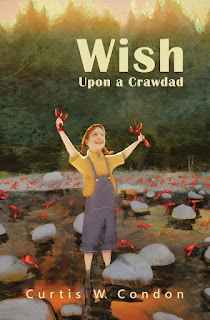
Twelve-year-old Ruby Mae Ryan has never had electricity a day in her life. But that's about to change. Electrification is coming to her rural Oregon town. She's determined to make enoughmoney by selling crawdads to the local restaurant and through other odd jobs tobuy something very special that she’s kept a secret from everyone but her Daddyand her best friend, Virginia. A lot of people wish on the first star at night. Ruby does that, too, but she also wishes on the first crawdad of the day. She figures the odds are better. "Not many folks wish upon a crawdad," Ruby says. Set in 1940, at the tail end of the Great Depression, this story tellswhat it was like in a time before electric cooperatives brought power to therural farm country.
Echo Mountain by Lauren Wolk (published by Dutton Books forYoung Reader, April 27, 2021 EAN/UPC 9780525555582)

When twelve-year-old Ellie's family loses their home in the Great Depression, they are forced to leave their home in town and start over in the untamed wilderness of the Maine woods. Echo Mountain is good for Ellie, who calls herself an 'echo girl'. She and her father take to living off the land, but her sister and mother do not. Her six year old brother Samuel seems to fit in anywhere. But then a terrible accident that is unfairly blamed on Ellie leaves her father in a coma. Determined to help her father, Ellie follows a wild, brindled dog to Cate, a reclusive woman living on the mountain who's called “the hag,” but has the knowledge that Ellie needs to help her father. Lauren Wolk is a Newbery Honor and Scott O'Dell Award–winning author, and this tale of resilience, persistence, and friendship across three generations of families is a testament to her skills.

Ten-year-old Margaríta Sandoval's family leaves New Mexico, where they have deep and traditional roots, to move to Fort Steele, Wyoming when her father finds a job with the railroad. She misses living among Hispanics, especially her beloved Abuelita, and feels so rootless that she fears the wind might blow her away. Margaríta meets Evangeline and is pleased to have a friend her own age, but soon encounters prejudice and misunderstanding. Things get really tense when the Sandovals learn that Abuelita might lose her land and the family's ancestral home unless they can pay off her tax bill. This lovely, gentle story is sprinkled with Spanish dichos, wise sayings that will ring true in any language. It teaches about a culture that few understand was here and thriving for centuries, and continues today.
If the Fire Comes by Tracy Daley(Published by North Star Editions, September 1, 2019, 978-1631633713
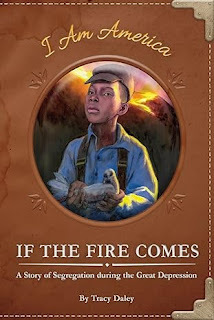
Eleven-year-old Joseph McCoy shines shoes to help his family survive. His family is one of the few black ones in Elsinore, a mostly white, California community that's been hit hard, both by the Great Depression and persistent drought. When an all-black Civilian Conservation Corps camp comes, racial tensions spread like wildfire and threatens to destroy the whole town. This book has extensive backmatter, including historical photographs and background information.
Perspective by Jennifer Bohnhoff (published by Thin Air Books, October 7, 2025, 979-8290306100)
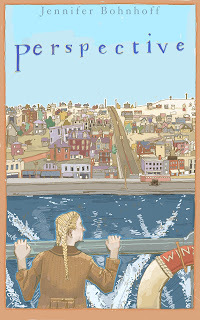
When her mother dies of lung cancer in the middle of the Great Depression, twelve-year old, artistic Genevieve Williams is shipped off to a father she has never met. She lands on a remote island in the middle of Lake Superior, where she finds herself dealing with isolation and a lifestyle that is a hundred years behind the times. Just as she unravels the mystery of her parents' broken relationship, and learns to love the island's rustic beauty, the government threatens to take it all away by making the Island into a National Park. Genevieve must find a way to protect her gentle, but flawed father without giving up her dreams to become an artist.
Nonfiction
The Great American Dust Bowl: A Graphic Novel by Don Brown (published by Clarion Books, October 8, 2013, 978-0547815503

Seems like every class I taught had one kid who preferred nonfiction to fiction, and one kid who loved pictures more than text. This is the book for that kid! This graphic novel is a short, easy reading history lesson, with evocative, sepia-toned pictures and text that is simple to read, but thoroughly researched. He includes scientific explanations for the dust storms of the 1920s and 1930s and includes his sources at the end, which makes this a great jumping off point for further research. Nonfiction graphic novels are a compelling way to get non readers into a subject. I think every classroom in America needs to have this book on its shelf.
Inspiring Stories From The Great Depression For Kids: True Tales of Resilience, Kindness, and Strength to Bring History to Life for Children (by Ahoy Publications, March 3, 2025, 979-8892964210)
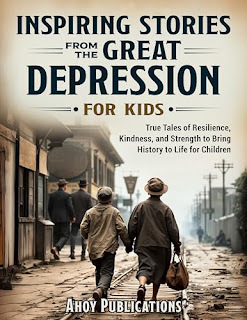
I've gotten to the point where I don't trust books that don't list author names, and this is one of them. Furthermore, the illustrations look really AI to me. That being said, this book has a collection of short chapters on different subjects related to the Great Depression and will appeal to the same kids who lovedd The Great American Dust Bowl. There are chapters on orphan trains, dust storms, hobos and their secret signs, soup kitchens, the Bonus Army, and Woody Guthrie that just might compel a reader into learning more.
Children of the Dust Bowl: The True Story of the School at Weedpatch Camp by Jerry Stanley (Published by Yearling, January 1, 1992, 978-0517880944)

Another brilliant piece of nonfiction for middle grade readers, this is the true story about the children of farmers who left the Dust Bowl and traveled Route 66 to California in search of jobs, only to find deprivation and discrimination. The emergency farm-labor camp immortalized in Steinbeck's The Grapes of Wrath had no schools for the children of Dust Bowl migrant laborers, who were ostracized as "dumb Okies." Then
Superintendent Leo Hart found a way to acceptance and inclusion for those who had been rejected and helped 50 Okie kids to build their own school in a nearby field Illustrated with photographs from the Dust Bowl era.
I will be giving away my slightly used copies of Not Lucille and The Wind Called My Name, and three new copies of Perspective to subscribers to my email list. If you are not a member and would like to join, click here. Winner will be announced in her November email.
The titles of the books in this article contain links to Bookshop.org, an online bookseller that gives 75% of its profits to independent bookstores, authors, and reviewers. As an affiliate, I receive a commission when people buy books by clicking through links on my blog or browsing my shop at https://bookshop.org/shop/jenniferbohnhoff. A matching commission goes to Page One Books, an independent bookseller in Albuquerque's Northeast Heights.
Please do not see my affiliation with Bookshop.org as a discouragement to shop directly at your local independent bookseller or to borrow from your local library.
September 18, 2025
Walking the Wall: Day 10, Wylam to Newcastle

When my husband, four friends and I walked Hadrian's Wall this past June, we did it in ten days. Some people walk the wall in four or five days. I think they miss a lot by going so quickly. There are so many interesting vistas, museums, and ruins to see! Some truly crazy people do the wall in one go. The current record is held by Jarlath McKenna, who ran from Segedunum to Bowness-on-Solway in 12 hours, 31 minutes, and 23 seconds on February 1, 2025. You'd think that going that fast, Jarlath wouldn't have seen anything, but he wrote that the route was lovely and the views in the middle section were stunning. He wore a headlamp for the first four hours, but finished well before sunset, in time to catch the bus back home.
On our last day, we planned to walk from Wylam to Wallsend, a town that has become just one neighborhood within the sprawling metropolis of Newcastle.
Wylam is off the Hadrian's Wall path. We'd been forced south when the owner of the place we had planned to stay in Heddon-on-the-Wall had cancelled our reservations because she had to to into the hospital. It is just south and west of Heddon-on-Wall, so catching up with the trail would not have been too difficult.
 However, the night before we were to make this last push, we began to have misgivings about day 10. Here's why:
However, the night before we were to make this last push, we began to have misgivings about day 10. Here's why: 1. Our final destination was Segedunum, the fort that guarded the eastern end of the wall (and hence the name of the neighborhood, Wallsend.) Segedunum was not only the place we would stamp our passports for the last time. It had a museum, the ruins of the fort, and a reconstructed bathhouse. We'd been through enough museums to know that we would regret it if we didn't spend more time than budgeted on Segedunum.
2. Newcastle also has the Hancock Museum, which was not only free (my favorite admission price!) but also highly recommended. We wanted to make sure we had adequate time to study its Roman artifacts.
3. Arbeia, the Roman fort that guarded the southern bank of the River Tyne, is in Newcastle—and also free!
4. Becauses Newcastle had a major event that day (Sam Fender, a rock star, who grew up in Newcastle, was giving a concert), hotel rooms were are scarce as hen's teeth. We ended up taking rooms on the North Sea coast, east and north of Newcastle and were a little nervous about getting there at a decent time.
5. Although we were now seasoned hikers, and the 16 or so miles would not be impossible, the trail was entirely on cement sidewalk and asphalt and went through some industrialized areas near the river. I'd seen a few posts on social media from hikers who were bothered by young thugs, and other posts that said the areas were perfectly safe for hikers, and I was a little unsettled by the prospect.
After considering our options, we decided not to hike the last section. Instead, we took the train from Wylam to Newcastle.
We didn't feel bad about not walking the last day. We had already walked far more than 100 miles, and the wall path between Bowness-on-Solway to Wallsend is 84 miles, so we more than made up the distance with side trips and wanderings.
And even with taking the train, we ended up not being able to see everything we had wanted to see. We toured Arbeia the next day, then took the train to Edinburgh, where we would catch and early morning flight the day after.
We ended up logging a good 8 miles, just by walking through Newcastle and the various museums.
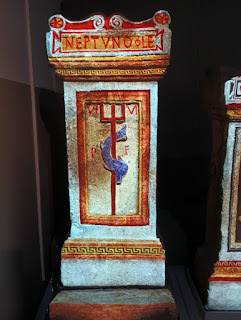 The Hancock Museum was EVERYTHING we'd hoped it would be. The displays followed real people
The Hancock Museum was EVERYTHING we'd hoped it would be. The displays followed real peopleand their experiences living in Roman Britain, giving life to artifacts that might otherwise have just been pretty objects. I was especially impressed with a display of Roman altars that began showing them how they are now (plain, gray stone) and then used lights to superimpose the colors that were likely to have been on them when they were originally dedicated. This altar to Neptune was so much more vivid when colored.
Segedunum was a bit of a disappointment. Its museum looks a little tired and the baths, which I'd really hoped to go through, were closed for renovations. It was nice, though, to stand beneath the sign that mirrored the one we had stood under on the morning when we began our walk in Bowness-on-Solway, and to get our passports stamped for the last time.
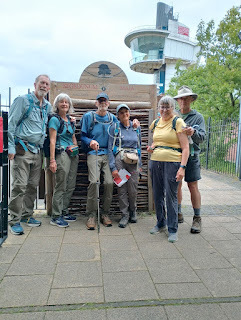
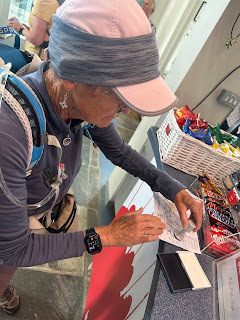
The trip from Newcastle to WhitleyBay, where we were spending the night, ended up to be more of an adventure than we'd planned, and I was grateful that we'd allotted more time than we thought we needed. Newcastle's Metro runs to Whitley Bay, and timetable indicated that we could get there in fifteen minutes. The metro was filled with Sam Fender fans, who were wearing the local team's soccer jerseys because Fender is apparently a big supporter of the team and his concert was being held in the soccer arena. Many of these fans were opening drinking, and raucously drunk, which made us uneasy. Luckily, no fights broke out. However, we were halfway to Whitley Bay when the train stopped and an announcer said that we could go no further. Apparently, a tree had fallen over the tracks (or there had been a car wreck at a crossing, or a power line had gone down. By the evening, we'd all developed different interpretations of the muffled public announcement) and we were all to get off. The conductor swore that the local buses would honor our metro tickets. We wandered about whatever town we were in, trying to find a bus stop going in the right direction. Finally a local man stopped and asked us if we were lost. He walked us to the right bus stop, but the driver of the next bus insisted that the bus and metro were two different systems and that our metro tickets were no good. Many of the locals walked off, but we were too tired to argue. We paid the bus fare.
Whitley Bay turned out to be a beautiful place to end our adventure. We dipped our toes into the frigid waters of the north sea and I picked up many bits of green and blue sea glass to help remind me of our great adventure.
Hiking Hadrian's Wall is something I've wanted to do for over fifty years. I'm glad that I did it. The scenery varied from gentle, sheep filled fields to stunning, hilly vistas. The museums were extraordinary. And everywhere, the people of Cumberland and Northumberland were helpful and kind. I hope to go back someday and hike another of Britain's historic and scenic trails.Jennifer Bohnhoff is a former history and English teacher who has written a number of historical and contemporary novels for middle grade and adult readers. She is currently at work on a novel set along Hadrian's Wall during the Roman period.
September 12, 2025
Walking the Wall: Day 9, Robin Hood Inn to Wylam
In June 2025 I walked the trail along Hadrian's Wall. We began in the west and hiked with the wind at our backs for ten days. Although the trail is 84 miles long, we hiked well over 100 because of deviations to see things off the trail. If you'd like to start at the beginning, click here: https://jenniferbohnhoff.blogspot.com/2025/06/walking-wall-getting-to-starting-place.html
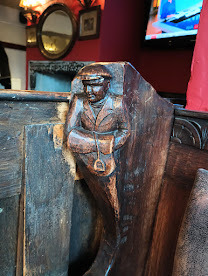
On the morning of day 9, we awakened to the pattering of rain on the roofs of our little cabins tucked behind the Robin Hood Inn. We were treated to a full breakfast in the Inn, which is loaded with lots of fun things to look at. There are antlers and full, taxidermied heads hanging on the walls, lots of old pictures, paintings and photos, plus some interesting furniture, including wooden booths carved with the likenesses of people. This groomsman, carrying a saddle, was one of the charming carvings.
By now, we had left the wild and rolling hills of the middle part of the trail far behind us and were entering into flatter and much more populated country. The little towns began to meld together into suburbs, and although we didn't see many people along the trail, we heard constant traffic along the road which our trail paralleled.
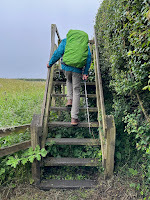
The day was misty, and we hiked over stiles and through meadows with tall grass that coated our pants, but it never rained hard and we were never soaked through and through. We chose to go to England in June because, at least statistically, it is the driest month of the year. I believe we only had one or two days on which we weren't rain on—and April and May had seen a drought in which it didn't rain at all for six full weeks!
The moral of the story is, hope for the best but plan for the worst.
The Military Road took us into Heddon-on-Wall, a lovely, quaint town with numerous pubs. We stopped at the Three Tuns for lunch, and found the place filled with patrons wearing their finest. The women wore dresses, and the men were either dressed in military uniforms or in suits, and we, in our raincoats and with backpacks slung on our backs, felt very out of place.
On the TV screens, a large parade was in progress, and we soon learned that it was the King's birthday, and that the parade we were seeing was taking place in front of Buckingham Palace. We were never able to ascertain whether the people in the pub were associated with nearby Albemarle Barracks and were celebrating the King's birthday, or whether there had been a wedding or other celebration. Whatever it was, the partygoers stayed at the bar while we ate at a table, and all was well.Heddon-on-Wall was the last place we could see the Wall itself until we got to the reconstructed pieces at the very end of the trail. As in the far west of the trail, the wall through this section has been largely "appropriated" over the years. Many of the stones are now parts of farmhouses, churches, and
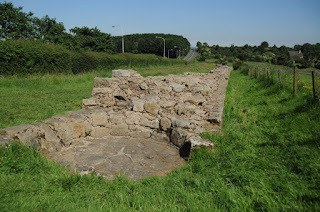
field walls. Sometimes people didn't move the stones very far before they reused them. In Heddon-on-Wall there is a wheat drying kiln that was built right into a section of the wall sometime during the late middle ages.
We had intended to stay the night in Heddon-on-Wall, at an establishment called Hadrian’s Barn. However, less than a week before I left for this journey, the proprietor sent me an email saying that she had to go into the hospital. She referred us to Ship Inn, in Wylam, so we ended up walking south an extra couple of miles.
Those couple of miles ended up being quite an adventure. I'd mapped our entire journey on AllTrails, each day door to door. While we didn't use it much, relying more on the acorns that were nailed to posts along the way, the app came in handy whenever we managed to go off trail. However, I'd never added in the short bit between where I had thought we'd stop in Heddon-on-Wall and where we actually did stop. Without a trail marked out, and since Wylam was not along the Wall Trail (and therefore there were no acorns to follow), we wandered into a rather posh country club with a lovely golf course.
I'm sure the golfers were as surprised too see a group of pack-laden hikers strolling down the fairways as the well dressed people in the pub had been, but they, too, were nice about it. One even told us where there was a break in the hedge so we could slip out and get onto a trail that led to Wylam.
 The trail that took us into town is called the Wylam waggonway, built in 1748 to transport coalfrom
The trail that took us into town is called the Wylam waggonway, built in 1748 to transport coalfromWylam to a dock on the River Tyne. The coalwaggons were originally pulled by horseson wooden rails. In 1829, a local man named George Stephenson showed off his locomotive, the Rocket, along this section of track. It managed to pull a load of three times its own weight at the dizzying speed of 12.5mph, and hauled 20kph and hauled a coach filled with passengers at 24mph, securing the locomotive's place in the Industrial Revolution.

That night we slept in The Ship Inn, an old public house under new management. We'd just gotten to our rooms when a great gully washer of a storm blew through, and glad we were to be under a good, solid roof.
The next day was to be our last along the trail, and most of it was to follow along the River Tyne, through increasingly urban and industrial neighborhoods. At the end, we would be in Newcastle, which had several fine museums that we wanted to spend time in. It was clear we would face a decision tomorrow.
September 8, 2025
Wolves and Moose on Isle Royale

People often assume that nature, if left to her own devices,is stable and unchanging. They believe that change is caused by human tinkeringor interference, and it’s always bad.
But this is not the case.
While humans can and do change their environment, they arenot the only causes of change. Some happen naturally. A good example of thishas occurred on Isle Royale, an island in Lake Superior which is now part ofthe National Park system.
Isle Royale is now famous for its wolf and moosepopulations. Because it is quite isolated and only has one dominant predatorand one dominant prey, it is the ideal place to study the relationship betweenthe two species. Durward Allen initiated the Isle Royale Wolf-Moose project in1958. The study is still going on.
But neither wolves nor moose have been on the island forlong, and it is likely that neither are there because of human tinkering orinterference.
 In the early twentieth century, the largest mammals on IsleRoyale were the Canadian lynx and the boreal woodland caribou, a subspecies ofreindeer found primarily in Canada with small populations in the United States.Archeological evidence indicates both of these species had inhabited IsleRoyale for 3,500 years. Their demise on the island can be attributable to humanactions such as hunting and trapping and loss of habitat through mining,logging, and fires. But it is likely that the arrival of competitors alsocaused the lynx and caribou population to dwindle to nothing. Those competitorsarrived on the island not by human intervention, but by their own initiative.
In the early twentieth century, the largest mammals on IsleRoyale were the Canadian lynx and the boreal woodland caribou, a subspecies ofreindeer found primarily in Canada with small populations in the United States.Archeological evidence indicates both of these species had inhabited IsleRoyale for 3,500 years. Their demise on the island can be attributable to humanactions such as hunting and trapping and loss of habitat through mining,logging, and fires. But it is likely that the arrival of competitors alsocaused the lynx and caribou population to dwindle to nothing. Those competitorsarrived on the island not by human intervention, but by their own initiative. It turns out that Isle Royale is not as remote as it would seem.At least, not throughout the year. The 14 miles between the Minnesota shorelineand the island may be impossible to swim for most species, but it can be easilytraveled when the water freezes over. Lake Superior last froze over completely in 1996. In 2014 and 2019,ice covered over 90% of the lake’s surface. Ice bridges, narrow pathways of icethat can reach from the mainland to the islands, are more common.

Ice bridges are probably how coyotes managed to appear onthe island around 1905. Often called brush wolves in the diaries and accountsof Isle Royale Islanders, these canine predators ate snowshoe hares, squirrels,and other small mammals. This put them in direct competition with the Canadianlynx, whose numbers declined until it was believed to be completely gone fromthe island by the 1930s. However, there have been occasional sitings of lynx,the most recent being in 1980. Whether there was a small resident population ofreclusive lynx or the cats crossed back and forth over ice bridges is up fordebate.
Moose first arrived on Isle Royale soon after coyotes, with1909 being the most likely year. There are several theories about how the bigmammal came. Some suggest that they were stocked on the island for the purposeof recreational hunting. This seems unlikely. If someone had managed to captureand cage several moose, then transport them to the island, they would have leftsome sort of documentation; managing such a feat with so large and bad temperedan animal demands serious bragging rights. Other sources suggest that moose swamacross Lake Superior from Minnesota,

and while a long distance, moose arestrong swimmers and this could be possible. It is more likely that moose usedan ice bridge to reach Isle Royale, just as the coyote had. Moose and cariboucompeted for the tender shoots and buds of willow, aspen, and birch untildeciduous trees were largely eradicated. The last boreal woodland caribou onIsle Royale was documented in 1925. Now, moose rely on balsam fir and, whenother food sources are overgrazed, lichen. For fifty years, their numbersfluctuated in a boom-and-bust cycle, rising when weather conditions were good andfood abundant and declining in years of scarcity and harsh weather. And thenwolves came.

In 1949, during a particularly harsh winter, wolves crossedan ice bridge from Ontario to the island. No one is sure just how many wolvesarrived, but it could have been a single pair. Wolves flourished on the largemoose herds, outcompeting the coyotes, who disappeared within a few years.
Without much (or any) human intervention, three species: thelynx, the caribou, and the coyote had left the island and the moose and wolfhad taken their place.
In 1958, when Durward Allen initiated the Isle RoyaleWolf-Moose project, he and other ecologists expected to document a “balance ofnature” in which the wolf and moose populations became relatively steady inrelation to each other. They believed that when moose herds increased, wolfpopulations would also. What actually happened was much more complicated. Themoose population has ranged from as low as 500 to as high as 2500. The biggestdrop in population came in 1996, when the most severe winter on record and anunexpected outbreak of moose ticks caused the population to collapse. It seemsdisease can affect moose populations as much as predation from wolves.
Wolf populations have been erratic as well, ranging as highas 50 to an unsustainable two. In 1980 the wolf population crashed after humansinadvertently brought the disease canine-parvovirus to the island. By thelate 1990s, it was clear that the small number of wolves that had begun theisland’s packs had led to inbreeding, which was weakening the individuals. In 1997,a single male wolf crossed from Ontario on an ice bridge, reinvigorating thegene pool. It appears that in 2008 two wolves left the island the same way.
By 2017, when there were only two wolves left of the island,authorities decided to step in and help nature restore her balance. After somedebate as to whether the introduction was an unnatural intervention, fourwolves were brought from Minnesota in 2018. The next year, another 15 wolves were releasedat Isle Royale in hopes of bringing stability to the ecosystem.
As of early 2024, the wolf population on Isle Royale isestimated to be around 30 wolves, which represents a stabilized population in fourdistinct wolf packs. Now, Park Service wildlife biologists are talking aboutbringing back the lynx.
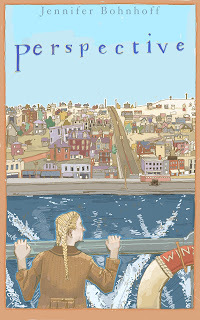
My historical novel, Perspective, is set in the 1930s, so the moose was on the island, but the largest predator was still the coyote. It tells the story of Genevieve Williams, an artistic 12 year old girl who is put on a ferry to Isle Royale to live with a father she's never met. Genevieve has one terrifying encounter with a moose early on in the story, but learns to love the ungainly animals and the wild beauty of the islands. When the government decides to create a national park on the island, Genevieve tries to come up with a plan that will allow her and her father to stay. The novel, written for middle grade readers and up, will be published in early october and is presently available for pre-order.
August 27, 2025
Walking the Wall: Day 8, Corbridge to Robin Hood Inn
I walked Hadrian's Wall with my husband and four friends during June 2025. This is an account of our eighth day on the trail.
When we left Corbridge and walked north to rejoin the Hadrian's Wall path, we didn't expect to see much different than we'd seen on the way down the previous day. After all, we were walking the same path! But we surprise ourselves.
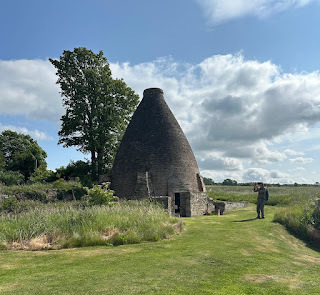
Our first surprise was Walker's Pottery, just north of town. The Old Pottery was a small family business, in operation from 1840 until 1910.
It produced firebricks, earthenware, tiles, pipes and agricultural wares using clay from a pit near the site.
The pottery is on private property, but the owners were gracious enough to allow the public access from 9am until 4pm through a pedestrian gate and footpath.
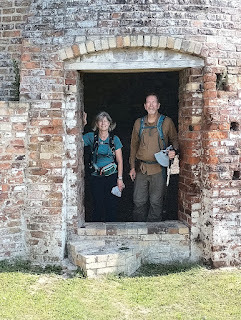
A lot of the original buildings still stand here. two horizontal kilns, one down draught kiln are beyond the area open to the public, but the two bottle shaped kilns were accessible. There are only 44 of these structures left in the country.
 Standing inside one was an awesome experience. Our voices bounced around in an eerie way, and watching the concentric rings of brick climb to the open circle at the top was calming and inspiring.
Standing inside one was an awesome experience. Our voices bounced around in an eerie way, and watching the concentric rings of brick climb to the open circle at the top was calming and inspiring.
After that, we passed Aydon Castle, a fortified manor house that's part of the English Heritage holdings.
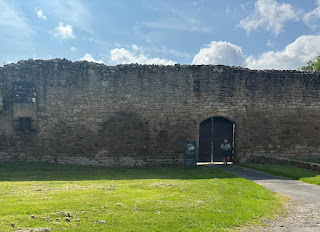
The website had said that the castle was open, and that we could buy tickets online or when we arrived. However, we found the place locked up, and no one around to let us in. We peeked through a crack in the door, then were on our way.
The English Heritage Website seems to indicate that Aydon Castle is closed until they develop a new reservation system.
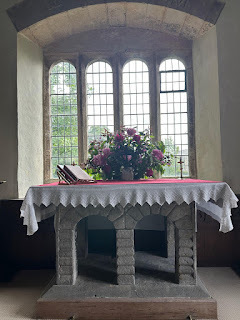
We then passed Halton Castle again. We'd passed it on the way south, but not stopped. This time, we walked through the cemetery and little chapel. Halton Castle is an example of a pele tower, a small fortified keep or tower house. Its first mention in the record is from 1382. The pele tower has four stories and a basement with a stone vault. There was another pele tower back in Corbridge. It was the home of the local priest, but is now a pub.
The chapel was a separate building. It is small, and probably could seat 20 people, but it clearly remains in use.
We finished the day at The Robin Hood Inn, in the town of Wallhouses. This Inn is one of the places we
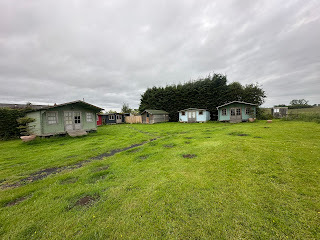
had to go to get our Hadrian's Wall Passports stamped. It is an old fashioned pub and dates from 1752. We were not able to get rooms in the building itself, but they've erected little cabins out back, each of which has two twin beds and a small bathroom. They also allow tents on their lawn. I don't know if we were early in the season, or if the rains kept the tents at bay, but there were none the night we were there.
I'd gotten a northern lights alert on my phone and was hopeful to see something spectacular. Alas, the whole night was cloudy, dark, and gray.

August 19, 2025
Breaking up with Prince Charles
 One of the big discussions about the recent marriage of Prince Harry and Meghan Markle centers on the fact that Ms. Markle is both an American and a commoner. But this isn't the first time an American commoner has made a bid for marriage with British royalty. I nearly did it myself forty years ago.
One of the big discussions about the recent marriage of Prince Harry and Meghan Markle centers on the fact that Ms. Markle is both an American and a commoner. But this isn't the first time an American commoner has made a bid for marriage with British royalty. I nearly did it myself forty years ago. In 1979, I had the unusual good fortune to study at the Centre for Medieval and Renaissance Studies in Oxford, England. Early in the Michaelmas, or fall, term, I bought a postcard, wrote a note to my mother, and posted it. Little did I know what a maelstrom I was unleashing.
I no longer remember the exact words that I wrote, but they went something like this: Dear Mum, I am having such a splendid time here. I have met the most wonderful man. He takes me to all the poshest places. He's introduced me to the most interesting of people. Next week I am going to London to have tea with his mother. I'm told she raises corgis. If I don't make it home for the holidays, do come to visit."
The joke was in the mention of corgis, since that is the kind of dog my family owned. Whenever anyone asked about our family's pet, a long haired Pembroke named Fluffy, my mother would proudly announce that she was the same kind of dog that Queen Elizabeth raised. I was sure my mother would get the joke.
 But she didn't.
But she didn't.Instead, my mother called my father on the phone and tearfully informed him that I was never coming home. My father, ever unflappable, asked her to read the postcard's note to him. He then told my mother to turn the postcard over. "It's a picture of Prince Charles, isn't it?" he asked, catching the joke immediately.
This threw my mother into an even bigger fit of pique. Not only was I marrying an Englishman and never coming home again, but that man was royalty! I'd be too busy with official state dinners and supermarket openings to even arrange a holiday visit!
My mother hung up on my father and called my boyfriend. Surely he could talk me out of this madness! Hank, ever willing to oblige my mother, caught a Freddy Laker flight to England that very weekend. When he returned, he informed my mother that all was well, and that I wasn't going to marry Prince Charles after all. A couple of weeks later, I wrote to my mother that Hank and I were engaged. I would return to America by Christmas and be married the next summer.
My mother really didn't breathe easily until Charles found someone else. About the same time that Hank and I married, news stories connecting Charles with a young woman named Diana Spencer began circulating. They were married a year after I married Hank, my own Prince Charming.
My marriage has fared much better than Diana's. After 38 years, we're still happy, and my mother continues to be grateful that Hank managed to steal me away from Prince Charles.
 Jennifer Bohnhoff teaches middle school and writes historical fiction and other flights of fancy. Although none of her three sons will ever ascend to the throne, she and her Prince Charming of a husband live a fairytale existence in rural New Mexico. Their sole subject is a cantankerous cat and, sadly, they have never owned a corgi
Jennifer Bohnhoff teaches middle school and writes historical fiction and other flights of fancy. Although none of her three sons will ever ascend to the throne, she and her Prince Charming of a husband live a fairytale existence in rural New Mexico. Their sole subject is a cantankerous cat and, sadly, they have never owned a corgiYou can read more of her blogs and get information about her books at www.jenniferbohnhoff.com
August 13, 2025
Walking the Wall: Day 7, Chollerford to Corbridge
Our plan was to deviate from the wall trail to see Corbridge. We’d planned to take a 7-mile diversion south, through Acomb and Hexham, but members of our group wanted to walk as much of the wall trail as possible, so we went all the way to Portgate before going south
We began the day with breakfast at The George Hotel instead. Theirbreakfast was served buffet style, and it had a lot to offer. Highly recommend!The George also packed lunches for us.
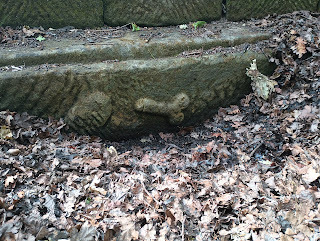
We began the dayby searching for the penis carved into the base of the Roman bridge atChesters. I used to teach middle school, and I’ve seen my share of penises carvedinto desks and drawn into text books. It turns out the Romans were middleschoolers at heart. To them, a penis was (as I assume for many middle school boys)a sign of virility and power. My guess is they carved it into the bridge tokeep the bridge upright and strong.
After alittle over an hour of walking, we arrived at
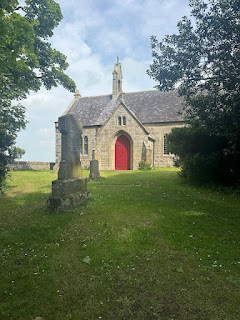
St. Oswald’s church, siteof the battle of Heavenfield. In 633 or 634, a Northumbrian army under Oswaldof Bernicia, who later became St Oswald, fought a Welsh army under Cadwallon apCadfan of Gwynedd. Oswald won afterseeing a cross and calling upon it for help. Heavenfield is the end of the St Oswald’s Way,another long-distance path in Northumberland that goes south from the HolyIsland of Lindisfarne to Hadrian’s Wall.
The inside of the church was lovely, and it had an old Roman altar that (I think) was used as a baptismal font at one point, and later as the base for a cross. It's interesting to see how old things have been adopted for new purposes over the millenia.
Because wecontinued from this point along the Wall trail, we missed Hexham, which has anAbbey that is worth a visit. The abbey has a good café that comes highlyrecommended.
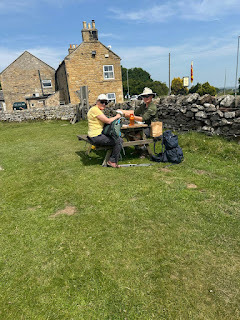
Instead, wewalked through Stanley Plantation, which is a pine forest that has been logged quitea bit and wasn’t particularly pretty. Just beyond that, however, we came toPort Gate, which one had a large Roman gate that let travelers along Rome’sDere Street pass through Hadrian’s Wall. At the junction, there is now a lovelyestablishment named the Errington Coffee House which made us wish we didn’thave packed lunches.
We walked ashort bit, then turned south at Halton Chester’s Roman Fort (Onum), which isunexcavated, so all we saw were mounds that have now become telltale for us.
We thenpassed through Halton, a little village with a lovely castle and chapel.

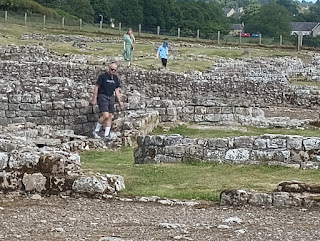
CorbridgeRoman Town is another English Heritage Site. Dating from 86AD when a fort wasbegun, it grew into a large town known to the Romans as Corstopitum. This wasthe most northern town in all the Roman Empire. The ruins are well explained withsignboards, and the museum has the Corbridge Hoard, a collection of Romanartefacts excavated in 1964. This is the first place we saw a dodecahedron, amysterious metal doodad whose purpose is still a mystery.
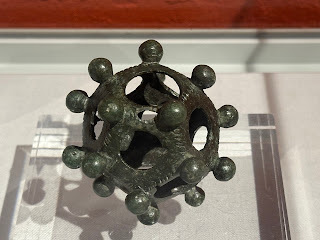
Golden Lion. We ate dinner and breakfast there as well, and can heartily recommendit. hello@goldenlioncorbridge.com 01434 239348 https://www.goldenlioncorbridge.com/

We walked about 13 1/4 miles on this day, so it was one of our longest, but we'd become stronger over the past few days and it didn't seem so bad.



